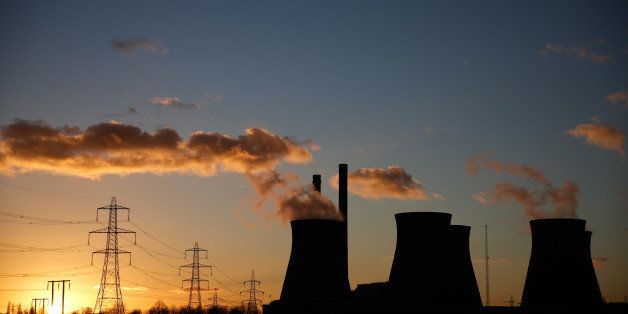
As a public interest attorney and law professor, I've admired Justice Antonin Scalia's strong intellect and passion even if I don't share his legal philosophy and sometimes think that his "vivid" writing style is neither civil nor constructive for the courts. As a compassionate person, I join with others in mourning his passing. As a dedicated environmentalist, I recognize the breath of fresh air that this turn of events infuses into the federal courts' review of the Clean Power Plan, which is a vital legal building block for United States' leadership to help solve global climate change problems. In short, the Clean Power Plan now has a better chance of being upheld on appeal during the incessant litigation brought by coal companies and some states to stop it from ever taking effect.
The U.S. EPA's Clean Power Plan is based on the Clean Air Act's requirement that the agency must regulate to reduce pollution, including carbon dioxide, which endangers public health. In Massachusetts v. EPA (2007) and American Electric Power (AEP) v. Connecticut (2009), the Supreme Court upheld the EPA's authority to regulate carbon dioxide and other greenhouse gas pollution under the Clean Air Act. For the power plant sector, the Clean Power Plan sets overall pollution reduction targets to be achieved by each state and provides flexible approaches to accomplish the results.
The Clean Power Plan isn't the only way for the United States to show leadership and meet its greenhouse gas pollution reduction commitments made at the Paris COP21 Climate Conference. Rapid improvements in solar energy and wind power equipment and in energy efficiency technologies, including LED lighting and better ballasts, are transforming and cleaning up the electricity sector. Congress recently extended the federal production tax credit for wind power and the federal investment tax credit for solar energy. That supports investments and accelerated growth of these clean technologies. These are important actions that can help hold down global temperatures and mitigate climate change.
The Clean Power Plan and these tax policies drive energy markets, and the clean technologies developed and deployed in the U.S. can be transferred to developing nations to help reduce global greenhouse gas pollution. Whether carbon dioxide pollution is emitted in Indiana, India, or Indonesia, it has the same impact in heating the atmosphere.
On February 9th, the U.S. Supreme Court, by a 5-4 vote, issued an extraordinary stay, which suspended the Clean Power Plan while certain coal companies and some states litigate their appeals of the EPA's rulemaking. The U.S. Court of Appeals for the District of Columbia's three-judge panel, which is hearing the appeal, had unanimously rejected the stay motion. Most experienced attorneys viewed the stay motion as a "Hail Mary" pass unlikely to succeed precisely because the Supreme Court had never granted such a motion in this type of case. Now, the Court has done so in short order without much legal explanation.
That short 5-4 stay order was procedural and did not substantively determine the case. The standards for a stay, however, require finding that the appellants demonstrate at least some reasonable possibility of success on the ultimate merits. The Supreme Court's shocking stay order not only indicated that there might be five Justices inclined to overturn the EPA's Clean Power Plan, but sent a warning signal to the Court of Appeals.
Now, the odds look better for the Clean Power Plan on appeal. Counting Supreme Court votes is an uncertain venture, but with Justice Scalia's passing, the numbers have shifted. Justices Breyer, Ginsburg, Kagan and Sotomayor, who dissented on the Court's granting of the stay motion, indicated their support for the Clean Power Plan as do their votes in previous cases. That's four votes.
On the other side, Justice Kennedy previously joined the majority decisions in Massachusetts v. EPA and AEP v. Connecticut, but surprised many with his vote to grant the stay in the Clean Power Plan case. His vote on the merits is up for grabs. Chief Justice Roberts joined Justice Ginsburg's majority opinion in AEP, presumably on stare decisis grounds, after dissenting from the majority in Massachusetts. Justices Alito, Scalia and Thomas all voted to grant the stay and were widely viewed to be likely votes against upholding the Clean Power Plan if and when the appeal reaches the Supreme Court on the merits.
The lineup of votes now shifts. Remember that much can change, just as it has with Justice Scalia's passing. The majorities on this landmark environmental case are fragile.
Scenario #1: President Obama's nomination of a new Justice is confirmed by the U.S. Senate, and that appointee provides a fifth vote joining with at least the current four Justices likely to support the Clean Power Plan. Yes, Senate Majority Leader Mitch McConnell and other Republican Senators and Presidential candidates immediately leaped up to announce that they would stop any nomination for the next 11 months. President Obama announced that he will move forward to "fulfill my constitutional responsibility to nominate a successor in due time." Senate Minority Leader Harry Reid urged the President to make his nomination soon.
The negotiations will soon begin. President Obama is the President for the next 11 months, and he is not going to sit on his constitutional responsibility and his opportunity to nominate a new Justice to the U.S. Supreme Court. The "typical" Senate hearing process on new Supreme Court nominees has been about 70 days in recent years. The longest hearing processes have been around 108 days. The Obama Presidency continues for 340 days.
There will be intense political pressure on the Senate Republicans, especially those who are candidates for re-election in challenging races, to not be deemed obstructionists with control of the Senate at stake in the November 2016 elections. If President Obama nominates a "confirmable" Justice, there may well be a fifth vote to uphold the Clean Power Plan when the case reaches the Court in 2017. It won't be easy, but it may be doable.
Scenario #2: OK. Senator McConnell and his fellow Republican Senators may stop the confirmation process no matter what. The D.C. Court of Appeals will be hearing oral argument in the Clean Power Plan case in early June 2016. If the three-judge panel upholds the Clean Power Plan - and the full Court of Appeals either denies rehearing en banc or upholds after an en banc hearing - then the first question is whether the Supreme Court grants a petition for certiorari. Almost certainly, yes. This is the sort of nationally important case that the Court usually decides. The second question is how the Supreme Court will rule on the merits: It would take five votes to reverse the Court of Appeals, and it's hard to see how to get there among the current eight Justices. On the other hand, if Justice Kennedy joins with Justice Ginsburg and three other Justices, as he did in Massachusetts and AEP, then that would provide a 5-3 majority to uphold the Clean Power Plan.
Scenario #3: Let's assume that Senator McConnell and his fellow Republican Senators stop the confirmation process no matter what. The next President will nominate the ninth Justice. Who's the next President? Who knows.
Who's elected President? Is it a Democrat who supports the Clean Power Plan, or does a Republican President attempt to undo the Clean Power Plan and appoint a new Justice who reflects Justice Scalia's views? Who controls the Senate following the November 2016 elections - Democrats or Republicans? What if Congress decides to amend the Clean Air Act or, as some hope, enact a carbon fee to replace the Clean Power Plan? What if another Justice retires or passes, thereby creating an additional vacancy and further shifting the alignment of votes?
Much can change before the Clean Power Plan case probably reaches the Supreme Court in 2017, but one thing is clear: Justice Scalia's unexpected and sudden passing appears to shift the votes and change the dynamics of judicial review in favor of the Clean Power Plan. For now.
